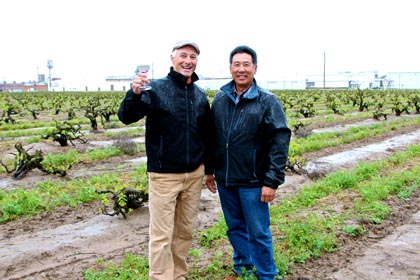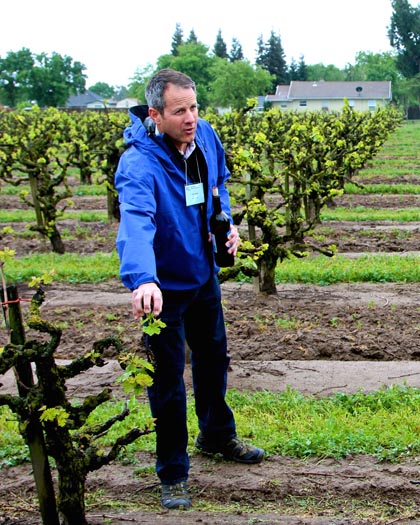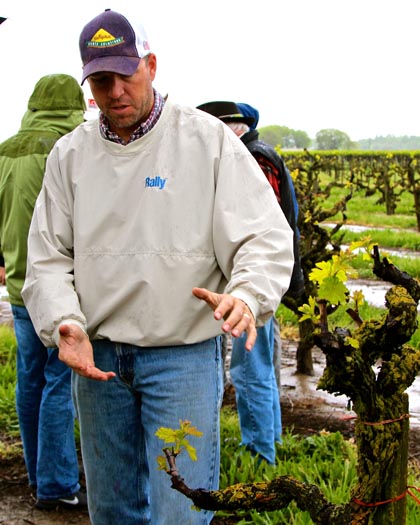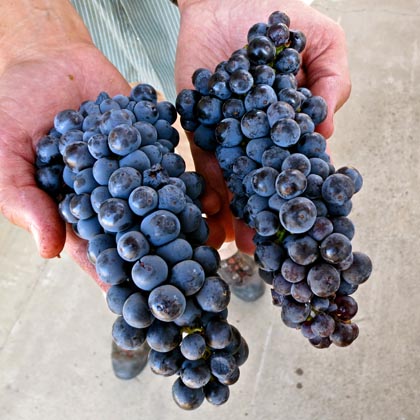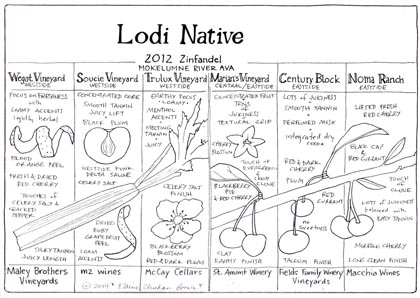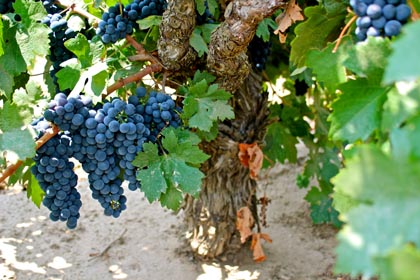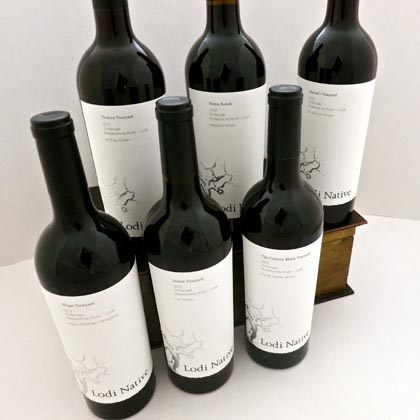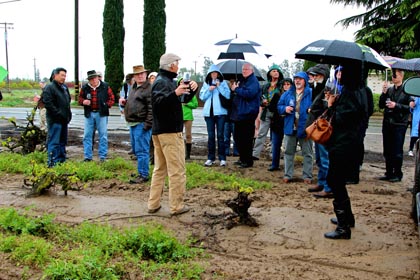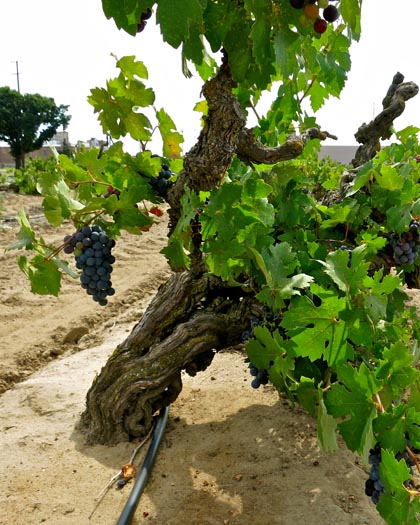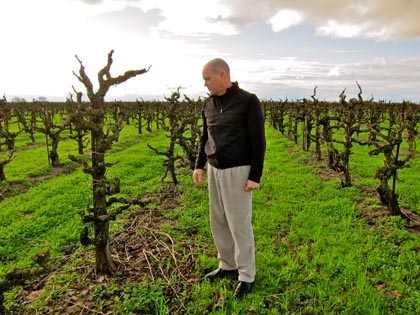Letters from Lodi
An insightful and objective look at viticulture and winemaking from the Lodi
Appellation and the growers and vintners behind these crafts. Told from the
perspective of multi-award winning wine journalist, Randy Caparoso.
Wine writers appreciate Lodi grown Zinfandel in unprecedented fashion
Macchia’s Tim Holdener and grower Leland Noma in Lodi Native vineyard, Noma Ranch
The Lodi Native project is making an impact on how the region is perceived from the outside
This past week, two widely read and respected wine bloggers – Elaine Brown of Hawk Wakawaka Wine Reviews, and Fred Swan of norcalwine.com – shared thoughts on the unique qualities of Lodi AVA grown Zinfandel in a detailed fashion that can only be described as unprecedented. At least for wine professionals living and working outside the Sacramento-San Joaquin River Delta.
Growers and winemakers in Lodi understand the subtle variations of wines grown in individual vineyards in a way that outside writers don't because they live Lodi vineyards and they breathe Lodi dirt and grapes. To the outside world, the reputation of Lodi Zinfandel is that of "big, fat, simple, super-ripe fruit bombs" – based upon the patently wrong assumption that, since Lodi is located at the upper end of the Central Valley, its climate must be desert-like compared to the climate of regions like Napa Valley or Sonoma County.
Maley Brothers winemaker Chad Joseph in Wegat Vineyard
Most consumers know Lodi as a great source of super-value wines: wine grapes like Zinfandel have traditionally been so easy to grow in Lodi that big wineries – from Michael David and DFV (Delicato Family Vineyards) to Woodbridge by Robert Mondavi and E. & J. Gallo – have been mining the region for years, producing lower priced wines from grapes grown more for volume than quality. In these types of wines, of course, vineyard individuality is a non-factor: value wines are bent, shaped and blended to meet brand and varietal expectations, not sensory expressions expected of a region, let alone vineyards.
But here's the rub: as recently as 30 years ago, big wineries like E. & J. Gallo were still taking more than 50% of the wine grapes grown in Napa Valley and Sonoma County for the same reason they continue to do so in Lodi. Not because Napa and Sonoma are sub-standard, "hot" regions, suitable only for making super-simple bulk wines; but because Napa and Sonoma are great regions for growing classic fine wines – something smaller, artisanal growers and producers now know very well.
Subsequently, of course, small artisanal style winegrowers began to dominate Napa and Sonoma, steadily driving up the grape prices and cost of farming in those regions. Today, the bigger wineries are still sourcing from the North Coast, but they focus even more on grapes from "outer" regions that they consider of equal quality, such as Mendocino, Lake County, Monterey, Santa Barbara, and of course, Lodi. You cannot, after all, realistically produce a $14 Zinfandel or $18 Chardonnay from grapes costing well over $4,000 a ton (a threshold surpassed in Napa Valley over 20 years ago); but you can from those other regions, where you can still get grapes for less than half the price.
But, as Mr. Swan duly noted in his recent blog, Lodi Zinfandel Goes Native, when reflecting on his observations gathered from the ZAP/LoCA sponsored The Lodi Zinfandel Experience on March 29, 2014, which featured the debut of the Lodi Native project:
Mohr-Fry Ranches’ Bruce Fry showing 113-year old vines in Marian’s Vineyard
Lodi is well known for Zinfandel. Of particular note are its many acres of old vines. Thick-trunked and twisted after all these years, they look more like short trees than grape vines.
The fruit these centenarians bear is full of character, but their unique traits are sometimes masked by new oak and other winemaking choices intended to please contemporary wine lovers. So, unlike Pinot Noir vineyard-designates often made with a minimum of intervention to expose distinct terroir, even super-premium Zinfandel wines don't necessarily reveal all the unique characteristics of particular old vine plots. This makes it hard to know exactly how excited we should really be about those vineyards.
Elaine Brown, who wrote her Hawk Wakawaka wine review on The Lodi Native Project, makes this observation:
Lodi offers some of the highest concentration of quality old vine material in the state of California. As vines age through vintages, they adapt their growing patterns to the conditions of their site, becoming more responsive to the intersection of factors–soil type, water availability, drainage, mineral content, sun, wind, and humidity exposure, etc–unique to their environment. The result yields fruit expressive through aroma, flavor, structure (and even color and size) of its peculiar vineyard.
Recently converted Lodi Zinfandel aficionados – especially those who have developed a taste for special single-vineyard bottlings by producers such as the six wineries participating in the Lodi Native project (Fields Family, m2, Maley Brothers, Macchia, McCay, and St. Amant) – have been appreciating these very same qualities over the past ten, fifteen years: qualities that are usually lost in the value oriented, big production style Zinfandels, where brand style and overt varietal fruitiness take precedence over vineyard expression.
Where the Lodi Native Zinfandels dramatically depart from Zinfandels produced even under these emerging small brands, says Brown, is "technique," and “goal”…
The (Lodi Native) wines are individually made using only ambient yeast fermentations, in neutral vessels, without the addition of anything beyond sulfur, without alcohol reductive techniques, and avoiding fining, or filtering. The wines, in other words, are produced with minimal intervention. The goal is to offer the best expression of the vineyards themselves.
Comparing Zinfandel clusters from Mohr-Fry Ranches (left) and Wegat Vineyard (right)
The result, adds Swan, is that…
The Lodi Native project… presents single-vineyards of distinction from Lodi's Mokelumne River AVA in wines that are skillfully made, but not "crafted." I tasted the project's first six wines. The differences between each were dramatic. The wines are beautiful. They compelled me to open my wallet, a much harder task these days than it used to be.
For further details on the minimalistic approach behind the six Lodi Native Zinfandels — and how to purchase them (available in 6-bottle wood cases at Lodi Wine & Visitor Center) — you can visit the Lodi Native Web site at lodinative.com (you can also read about the Lodi Native group’s presentation at the upcoming Lodi ZinFest Wine School on zinfest.com).
Perhaps even more significant are the tasting notes shared by Mr. Swan and Ms. Brown; revealing sensory delineations of rare insight, directly reflecting the locations, or terroir related attributes, of the six Lodi Native vineyards.
Because she thinks visually when assessing wines, for instance, Brown also composed this illustration of what she tastes in the Lodi Native Zinfandels:
Lodi Native Tasting Notes
Brown and Swan's startling tasting notes on the six, dramatically distinctive Lodi Native Zinfandels:
2012 WEGAT VINEYARD (MALEY BROTHERS)
Winemaker: Chad Joseph
Grower: Todd Maley
Swan: Wegat Vineyard is on Lodi's west side, an area noted for Zinfandel with spicy characteristics. Its 21 acres hold head-trained Zinfandel on St. George rootstock planted in 1958. The vines here are noted for producing unusually open clusters with small berries. Some whole clusters were used in making the Lodi Native wine to enhance complexity. The dark ruby wine is a study in cherries. The vivid nose shows red cherries and black, canned cherries, fresh cherries, macerated cherries, dried cherries and tart cherries. The cherrypalooza is decorated with fresh sage, garrigue and array of spice. The palate is intense, focused and quite long with flavors of red cherry, blueberry and a touch of sweet herb. The body is medium+ with notable freshness and just enough fine-grained tannins. 14.9% alcohol.
Brown: Of the three (west side Lodi vineyards), the Wegat… gives the most singular focus on fruit with a definitively red lift to the aromatics and palate characteristic of carbonic notes. The red fruit aromatics and palate are touched through by blood orange peel, and faint savory spice. I'm super-curious to see how this wine will continue to develop. As it is now, the Wegat carries the strongest focus on freshness of the collection with those carbonic elements rising from the glass. There are edges through the wine, however, that hint it will deepen in character and develop further complexity with time.
98-year old Soucie Vineyard vine
2012 SOUCIE VINEYARD (M2 WINES)
Winemaker: Layne Montgomery
Grower: Kevin Soucie
Swan: Soucie Vineyard is the furthest west of all the Lodi Native sites, very near both I–5 and the Delta. Kevin Soucie's meticulous care results not just in great fruit but a vineyard that looks like a massive Zen garden, hundreds of bonsai vines in a vast field of sand that's smooth as a U.S. Open sand trap. The particular block used in this wine was planted in 1916 and features deep, sandy soil that's so fine as to be nearly powdery. The vineyard is noted for a unique earthy character that ranges from mushroom to dairy yard notes. The nose features spicy, slightly resinous, forest floor, mushroom and a whiff of dill with plenty of sweet-tart berry fruit. The creamy, nearly full-bodied palate is intensely flavored with spicy berry fruit. The moderate tannins are fine-grained, the finish long. 14.5% alcohol.
Brown: Soucie Vineyard… shows the strongest influence of the west side funk with the loam elements deepening into loamy musk. At first sniff the funk can be surprising but with air it dissipates and integrates into the overall wine. The wine, however, shows up too with lots of juicy lift and pure fruit expression so that the dark earthy elements are paired alongside red juiciness. This wine likes air as the pairing of elements can then open and swirl together.
The six Lodi Native Zinfandels, available in a wood case package at Lodi Wine & Visitor Center
2012 TRULUX VINEYARD (McCAY CELLARS)
Winemaker: Michael McCay
Grower: Keith Watts
Swan: The TruLux Vineyard is also on the west side… its exceptionally tall vines were planted in the 1940s on St. George rootstock. Its wines are said to lean toward loamy flavors… aromas of earth, spicy dark plum and carob. In the mouth there's medium+ body, moderate, fine-grained tannins and marked acidity that provides juiciness throughout the lengthy finish. Flavors include tart and ripe blackberries, dry earth and spice. 14.5% alcohol.
Brown: Michael McCay makes the Trulux… focused on earthiness accented by floral aromatics and fruit flavors. The fruit and flower show up deepened by evergreen forest and loamy touches throughout and accented on the finish by dried beach grass and celery salt. This is a nicely focused, nicely balanced wine with lots of juiciness and a shantung textured tannin melting into juicy length.
2012 MARIAN’S VINEYARD (ST. AMANT WINERY)
Winemaker: Stuart Spencer
Growers: Jerry & Bruce Fry
Swan: Marian's Vineyard is an 8.3-acre plot within the expansive Mohr-Fry Ranch southwest of Lodi. All of the fruit from the 113-year old vines go to St. Amant winery. This deep ruby wine is softly aromatic, showing dry earth, gentle brown spice and introverted dark fruit. Silky tannins add interest on the creamy, full-bodied palate. Rich flavors of cocoa, savory herb, sweet yet tangy dark fruit and blackberry jam. 14.7% alcohol.
Brown: Marian's… rests on what would be the center-line between east and west side Mokelumne. However, the site showcases the soils more typical of east side plantings. The wine offers perfumed, concentrated fruit of an old vine planting with lots of juiciness balanced by light tannin grip. Light clay notes and musk lift appear in the wine and the fruit characteristics mix blackberry pie (without sweetness or jammy character) and red cherry with clove. This wine shows off the naturally concentrated while still lively flavor of old vine fruit.
Tim Holdener talking to consumers attending The Lodi Zinfandel Experience in Noma Ranch
2012 CENTURY BLOCK (FIELDS FAMILY WINES)
Winemaker: Ryan Sherman
Swan: The vines in this 3-acre vineyard in the far to the AVA's eastern side are own-rooted. They were planted in 1905 on the quick-draining sandy soil of talcum-powdery fineness… Lodi's east side is associated with Zinfandel of "red berry perfume and higher acidity." That's certainly evident in this feminine, Pinot-esque wine. Its attractive nose expresses three aspects of cherry: the red fruit, the blossoms and the leaves. The palate is also more delicate than the west side wines with medium+ body and prominent acidity balanced by very fine, delicate tannins. Flavors include red cherry, sweet spice and sweet herb. 13.9% alcohol.
Brown: The Century Block… offers lots of red and dark cherry with light plum (no sweetness) fruit concentration spun through with natural (not oak) dark cocoa, touches of red currant, and perfumed musk leading into a talcum finish. Though this wine carries lots of red fruit, the fruit is not the focus. Instead those fresh red elements come in clothed with evergreen and dry cocoa bringing a sense of rusticity to the wine.
+100-year old Noma Ranch vine
2012 NOMA RANCH (MACCHIA WINES)
Winemaker: Tim Holdener
Grower: Leland Noma
Swan: The portion of Noma Ranch Zinfandel that goes to Macchia comes from own-rooted, head-trained vines that are unusually low to the ground. More than 100 years old, they are dry-farmed and yield tiny bunches and berries with yields as low as one ton to the acre, resulting in very concentrated wines. The darkest of the six Lodi Native Zinfandels, this Macchia effort is opaque with a ruby-purple hue. Subtle aromas of dark berries, dark spice and ripe black cherry peak from the glass. The palate is much more outgoing: full-bodied with moderate, very fine tannins framing heady flavors of ripe black cherry, plum, spice, cocoa and oak char. (No new oak is allowed in Lodi Native, but once and twice used barrels can still yield flavors.). 15.0% alcohol.
Brown: The miniaturized vines of the Noma Ranch… offer lifted fresh red cherry with black cap and sour dark Morello integrated with natural fruit spice and touched by perfumed musk. The brilliance of older vines shows here as the Noma bottling turns out to have the highest alcohol level of the collection but carries it in good balance with lovely juiciness, concentrated flavor, and easy lightly drying tannin.
Mr. Swan's and Ms. Brown's conclusions? Says Swan, "The Lodi Native project has achieved its primary goal… the wines very clearly show the differences between some of Lodi's most-prized heritage vineyards… and, despite a commitment to sacrificing ideal balance and maximum deliciousness to achieve that aim, the resulting wines are very, very good."
Brown concludes, "Together the group focused in on the question of how to best express the wealth of Lodi vineyards… utilizing minimal intervention winemaking techniques. The result is a collection of six distinctive Zinfandels offering juicy while crystalline focus on the character that is Mokelumne River."
Winemaker Michael McCay in TruLux Vineyard
